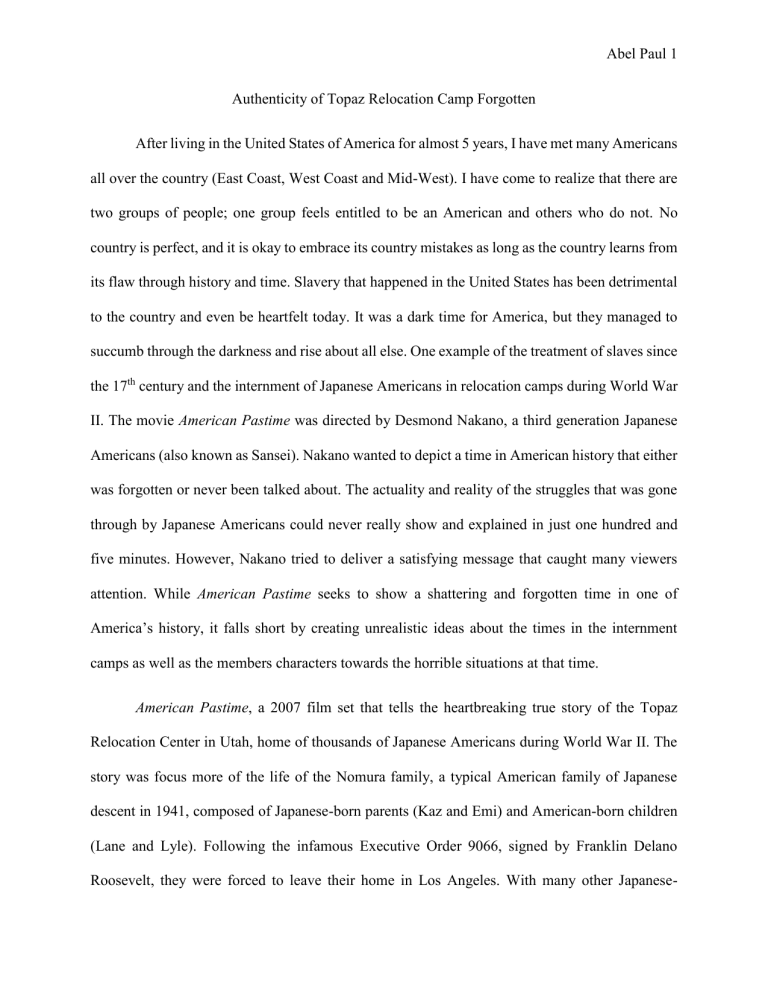
Abel Paul 1 Authenticity of Topaz Relocation Camp Forgotten After living in the United States of America for almost 5 years, I have met many Americans all over the country (East Coast, West Coast and Mid-West). I have come to realize that there are two groups of people; one group feels entitled to be an American and others who do not. No country is perfect, and it is okay to embrace its country mistakes as long as the country learns from its flaw through history and time. Slavery that happened in the United States has been detrimental to the country and even be heartfelt today. It was a dark time for America, but they managed to succumb through the darkness and rise about all else. One example of the treatment of slaves since the 17th century and the internment of Japanese Americans in relocation camps during World War II. The movie American Pastime was directed by Desmond Nakano, a third generation Japanese Americans (also known as Sansei). Nakano wanted to depict a time in American history that either was forgotten or never been talked about. The actuality and reality of the struggles that was gone through by Japanese Americans could never really show and explained in just one hundred and five minutes. However, Nakano tried to deliver a satisfying message that caught many viewers attention. While American Pastime seeks to show a shattering and forgotten time in one of America’s history, it falls short by creating unrealistic ideas about the times in the internment camps as well as the members characters towards the horrible situations at that time. American Pastime, a 2007 film set that tells the heartbreaking true story of the Topaz Relocation Center in Utah, home of thousands of Japanese Americans during World War II. The story was focus more of the life of the Nomura family, a typical American family of Japanese descent in 1941, composed of Japanese-born parents (Kaz and Emi) and American-born children (Lane and Lyle). Following the infamous Executive Order 9066, signed by Franklin Delano Roosevelt, they were forced to leave their home in Los Angeles. With many other Japanese- Abel Paul 2 Americans, they all were interred at a desolate desert camp. Kaz Nomura, a former professional baseball player formed a team with members of the camp including his talented son, Lyle. As for his other son, Lane, he enlists in the American Army to prove that is he just as much American as any other white Americans. Billy Burrell, one of the guards of the camp, has been trying very hard to be a professional baseball player for so many years. Over the period of the Japanese Americans living at the camp, Lyle and Katie, Billy’s daughter bonded with sharing their interest in music, eventually leading to a romantic relationship that was kept as a secret. Ultimately, the Topaz baseball team challenges Billy’s team to a game, where the prize was for either $2500 or a simple haircut. In the finals out of the game, Lyle steals home, knocking over Billy behind the plate leading him to evidently dropping the ball. At first, the referee calls him out but after some thought, Billy insisted that he was safe because the ball had dropped out of his hands. The Topaz team won the game and the crowd celebrates with joy and cheers. The final scene symbolically shows Lane receiving his haircut in front of all the other Japanese Americans members of the camp. The storyline of American Pastime dominantly shows the regretful decisions that the United States government has made in the past while bringing both sides; White Americans and Japanese Americans, struggling during these times and how they have endured it. Looking from the White American perspective, the Burrell family whose son was killed while serving in the war, they were constantly in fear for their safety. This was because their country was being attacked by the Japanese from Japan. On the other hand, the Japanese Americans, who were Japanese heritage, born and raised in the United States of America, pledging allegiance to the country and were ripped out of their home because the country was in fear of them. As an audience of this film, the storyline interpreted as a moment of clarity. This is said because, in the final scenes of the movie, Billy Burrell acknowledge that the people of the internment camp are just as much “Americans” just as Abel Paul 3 himself, his family and in fact, the rest of the county. While their skin colour may not be the same, however, the values that they share such as family and country, it is not different after all. In many senses, American Pastime fails to present the true sorrow and misery that the Japanese Americans experienced at the internment camp. Desmond Nakano, the director of the film chose to use romance stories, the passion for jazz music, a love for baseball and the loyalty for the country of wanting to fight the war to give a perspective of the terrible time in the American history instead of using authentic details of the reality of the trial and tribulations they went through. This can be seen in the beginning of the movie, where the Nomura family was forcef to leave their home upon signing the Executive Order 9066. There was very little resistance showed from the family. For a family that considers themselves as American citizens, they are being told that because of their Japanese heritage, they must give up everything due to the country’s fear. Upon arriving at the camp, all of the Japanese Americans seem to follow every order without any question or resistance. These scenes made me think of the history during the Holocaust, where the Jews were forced into concentration camps, yet the only difference was there was little authenticity on what really happened during the attack on Pearl Harbor. The quality of the internment camp is also contentious. This is because only at the beginning the members were shown sad about their living condition, but they were rarely seen unhappy about their new living quarters in the rest of the movie. They simply accepted all the circumstances handed to them and learnt to live happily with it. A foundational theme that is present in most American/Hollywood movies that is almost a must for most audience is romance. In American Pastime, we get to observe the love story of Lyle and Katie. Romance, baseball and the jazz music was prevalent in the movie that at times surpass the true meaning of this film. Both baseball and jazz music, which Lyle is very talented at, and Abel Paul 4 also known to be American favourite. However, there was no role in the film defining him as a “true American” yet separating him further away from that conclusion. Throughout the movie, Lyle is often mocked by Billy Burrell for his talents and because of his appearance, he made out to be less of an American and a person. It was very prominent that the people of the internment camp were treated very hard-heartly and unjust. With all this, the real question is why it is not portrayed that way then? Well, the real answer lies in the core of the movie. The film was created in a way to be informative and factual but got distracted by using the film to entertain the audience. Pretty sure Nakano wanted to portray the film to provide deep and insightful meaning of the movie to the time greatly impacted his ancestors. However, using the classic themes might have shifted the true meaning of American Pastime. Conclusively, American Pastime established relatable figure between White Americans and Japanese Americans through baseball, an American classic while illustrating a time in American history that was either forgotten or resisted against. Through using the dominant American film themes, audiences are introduced to the relocation camps during World War II and how the Japanese Americans were treated during that period of difficult time. The story of the Burrell and Nomura families allowed two different perspective to be illustrated in the movie. Through their lens, it gives the audience a better understanding of the United States at that time of history. Even though the 2009 film, American Pastime teaches the audience of vary backgrounds, through its narrative storyline about the heartbreaking American history. Yet, it fails to provide an authentic and real situations and stories of the Japanese Americans lives and experienced during their time in the internment camps.





